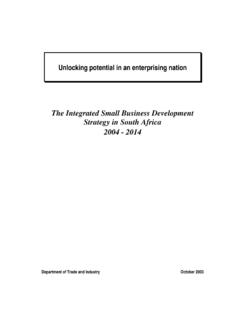Transcription of Integrated Small-Enterprise- Development Strategy
1 1. Integrated small - enterprise - Development Strategy A Summarised Version Unlocking the potential of South African entrepreneurs 2005 Department of Trade and Industry Integrated small - enterprise - Development Strategy 2. The Integrated small - enterprise Strategy Table of Contents Abbreviations used .. 3. 1. Purpose of the document 4. 2. Summary of strategic approach 4. 3 Core thrusts 4. Substantially strengthen support for SMMEs' access to finance 5. Create an enabling regulatory environment 5. Further expand market opportunities for specific categories of small enterprises 5. Localise small - business support through a grid of Seda-co-ordinated information and advice-access points 5.
2 Initiate a national entrepreneurship drive and expand education and training for small business 5. Co-fund minimum business -infrastructure facilities in local-authority areas across the country 5. 4. Vision and objectives 6. Strategic pillars of support 7. Targeted beneficiaries 8. Instruments to advance small - business Development 9. Instruments to advance small - business Development Improving access to finance 10. Improving access to markets 10. Skills Development 11. Regulations affecting small business 11. business premises and infrastructure 11. 5. Streamlining the institutional support framework 12.
3 Public-sector involvement: The key players 15. Local and district authorities (B 3 to B 5 15. Provincial authorities (B 1 and B 2) 15. Parastatals interacting with SMMEs (A 7) 15. Development -finance institutions (A 6) 15. National government (A 2 to A 5) 16. 6. Monitoring the Integrated Strategy 17. Integrated small - enterprise - Development Strategy 3. Abbreviations used BEE Black economic empowerment BIC business Information Centre CBO Community-based organisation CPSI Centre for Public-Service Innovation CSIR Council for Scientific and Industrial Research DBSA Development Bank of Southern Africa DFI Development finance institutions DIP Integrated Development plan DM District municipality DPLG Department of Provincial and Local Government DST Department of Science and Technology DTI Department of Trade and Industry EDU enterprise Development Unit (in the dti).)
4 FET Further education and training FET Further education and training (colleges). GDP Gross domestic product ICT Information and Communication Technology ICT Information and communication technology IDC Industrial Development Corporation ISRDP Integrated sustainable rural Development programme LBC Library business Corner LBSC Local business -Services Centre LED Local economic Development Mac Manufacturing Advice Centre MFRC Micro-Finance Regulatory Council NDA National Development Agency NEF National Empowerment Fund NGO Non-governmental organisation NPI National Productivity Institute PDI Previously disadvantaged individual PPP Public-private partnership PPPs
5 Public-private partnership RFI Retail finance institutions RIA Regulatory Impact Assessment SABS South African Bureau of Standards SADC Southern African Development Community Samaf South African Micro-Finance Apex Fund Saqi South African Qualifications Institute SARS South African Revenue Service SBDC small business Development Corporation Seda small enterprise Development Agency Sita State Information Technology Agency SMEDP small - and Medium- enterprise Development Programme SMEs small and medium enterprises SMMEs small , medium and micro-enterprises TEO The enterprise Organisation (in the dti).
6 Thrip Technology and Human Resources for Industry Programme Tisa Trade and Investment South Africa TWIB Technology for Women in business URP Urban Renewal Programme UYF Umsubomvu Youth Fund Integrated small - enterprise - Development Strategy 4. EXECUTIVE SUMMARY. The Integrated small - enterprise Strategy 1 Purpose of the document After the political transformation of 1994, government adopted the White Paper on the National Strategy for the Development and Promotion of small business in South Africa (1995). This White Paper created an enabling environment for the accelerated growth of small enterprises following a history characterised by the dominance of large, capital- intensive firms and the continued neglect of small enterprises.
7 The Integrated small enterprise Development Strategy presents the way forward for small - enterprise Development in South Africa over the next ten years ( 2005 to 2014). It is the result of a thorough process of review1, consultation, research and refinement and also takes into account the changing economic context. This process has built upon the successes of government in macro-economic Development and applies the experiences and lessons of the last ten years relating to small - enterprise promotion, while responding to the concerns raised by stakeholders within government, the private sector, organised labour and civil society.
8 In particular, the Strategy aims to address government's special Development goals to improve equity in terms of race, gender and geographical location. 2 Summary of strategic approach The Strategy is based on three pillars: promoting entrepreneurship through campaigns, leadership training and awards strengthening the enabling environment through more flexible regulations, better access to finance and markets, improved infrastructure facilities and business support, enhancing competitiveness and capacity at the enterprise level through skills training, more focused quality-, productivity- and competitiveness-support and the facilitation of technology transfer and commercialisation of incubation.
9 Across these three pillars the Strategy is to be underpinned by improved information and knowledge spread and management, including expanded research and communication as well as monitoring and evaluation of existing support programmes. A key strategic shift since the adoption of the White Paper is the integration of a wider group of institutions into the realm of small - business Development and a more co-operative approach of government towards its partners in the public and private sectors. In this context the main institutional reforms set out in the Strategy include the recent establishment of the small enterprise Development Agency (Seda) which will localise support through a national network of access points, the establishment of the South African Micro-Finance Apex Fund (Samaf) and a more focused approach by Khula to service small to medium-sized enterprises.
10 3 Core thrusts 1 Please refer to the Review of Ten Years of small - business Support in South Africa for further details. Integrated small - enterprise - Development Strategy 5. Within that strategic framework the document highlights six thrusts, which each need strong and sustained funding commitment by government, and the dti in particular, given its mandate to champion small business Development in South Africa in partnership with all spheres of government. Substantially strengthen support for SMMEs' access to finance Through a more targeted approach, the Apex Fund will focus more on survivalist and micro- enterprises, while Khula and other DFIs will mainly target small and medium-sized enterprises.







